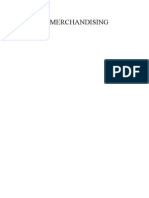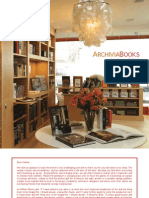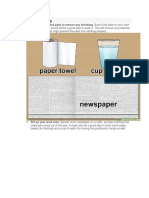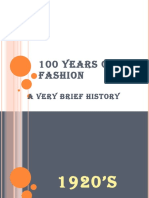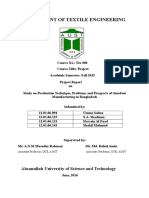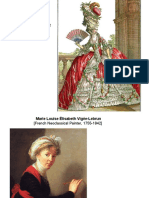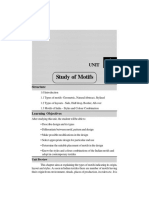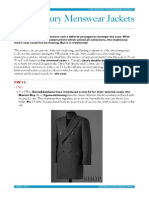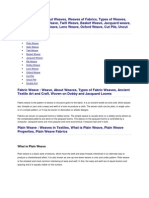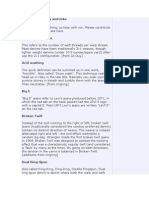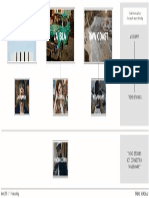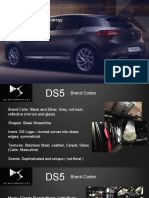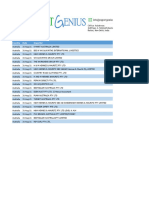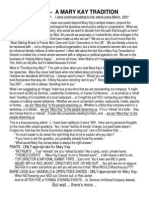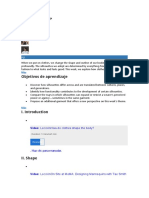THE
Abrasion:
Abrasion or friction between the surface of a fabric and any other.
Waterproof shelter:
Jacket in lightweight nylon, with closing in front, elastic waistband with
regulating devices at the waist andcuffs, usually has a
hood. Windbreaker.
Finish:
Series of processes by passing a fabric for to get a better look and
senstouch action.
Final touch:
Series finishes tissue for the purpose of improve its brightness,
fit,breathability, feel and performance in general. Clear finish or cut
finish
Suede:
Acabamen to that obtained through paint or pape l suede, transferred
to the fabric po r middleresin and heat, with getting the suede
appearance.
ACC:
Advances on contracts Exchange.
ACE:
Advances on Cam biais Delivered.
Accessory:
Element used in addition to clothing, such as handbags, scarves,
belts, jewelry etc.
Acetate:
Artificial fiber based on cellulose obtained by the viscose process
similar to that used as asubstitute of natural silk,consum the acetateIt
is reduced, especially in the case of applicationstextiles. While
providing similar general characteristics as those of rayon, does not
react well tonormal dyeing procedures, requiring the use of
techniquesspecial. Its biggestapplications are in the production of
cigarette filters, laces, satinsand material andstofamento.
Satin:
Glossy. Process aimed at polishing andpurity to tissues by friction.
Padded:
Cotton filling or synthetic fibers placed between two layers of fabric
and preso byseams, forming a regular decorative pattern or
irregular. Also known as quilting.From the Frenchmatelass.
Acrylic or polyacrylate:
Synthetic artificial fiber whose production ficommercial purposes
began in 1950 in the US.Features: light, soft and warm for the
winter,without elhante tocotton, and cool for the summer,shows
brightness when dyed with excellent strength.While it is less consumed
amongtextile chemical fiber, acrylicco, given its characteristics,
�occupies its own space in the industrytextiles made with the the
bestsubstitute for wool. The raw material is acrylonitrile (cyanidevinyl)
obtainable from ammonia, propilenos and oxygen.
Activewear:
Clothing to practice sports require great stamina. Contour adjusted to
thebody like a second skin, using high-tech fabrics, andoffering comfort
andallowing total freedom of movement. Original clothing line80s.
Damask:
Woven silk, linen or cotton with carved designs andm floral motifs
or geometric. Itsname derives from Damascus, the capital ofSyria.
Albene:
Fabric for clothing made from opaque acetate yarn.
Cotton:
Natural fiber derived plant cotton. The cotton fabric base has
m ldrmoisture absorption capacity is adequate for the Brazilian
climate,hot and wet. Thebody perspiration is better absorbed when
using tecido cotton in itscomposition. Features: soft and
comfortable; durable; resistant to wear, the lavact, the moth
andinsects; wash with ease; It tends toshrink and
wrinkle; wholesalefungi; burnt toeasily; not resist prchemical
oducts; Humidity limitation Do not mercerized:
Miami. Born wealth of new indstria, well represented in the
skyscrapers of New York,as the tower Chrysler or the Rockefeller
Center.
Art Nouveau:
Around the natural and feminine. Apesa r of the art nouveau style
express themselves princess ipalmente inarchitecture, interior
decoration and furniture, also included jewelry and fabrics.It is
characterized by lines graciosas, somewhat exaggerated, with
traces elongated ending inarabesques and motifs of flowers and
leaves.
Asymmetry
:Lack of symmetry.
Symmetry:
Appropriate proportion of the parts from one point to each other and
to the whole. Harmony resulting from certaincombinations.
At sight:
In cash.
Avant-garde:
In French - Vanguard. In terms of fashion, are the creatorsnontraditional and experimental thatset new trends as avant-garde.
AWB:
Abbreviation of Airway Bill. Getting to know airlift nt Bank.
B
�B / L:
Abbreviation of Bill of Lading. Cognac ecimento transport m artimo.
Frill:
Ruffled, pleated and ruffled falling freely gracing the clothes.
Baby doll:
Loose nightgown, with or without puffed sleeves, Complem Entada
byvoluminousknickers.
Open hem:
Cross point which is used to obtaining a decorative open junction
between two endstissue. Also known as lace pattern point.
Baize:
Terry cloth normalm being made of wool.
Ballerina:
Knitted fabric textured polyamide, of average weight.
Bandana:
Great scarf, brightly colored, made by process of theentura tie
dye. The bandanas worn bycowboys of the American West used to be
simple pieces of fabric, dyed in onecolor.
Italian pants bar:
External fold pants in the bar with two fingers wide. Hem facing; Italian
turns.
Baroque:
Far-fetched style, whose main characteristics are curved lines, of
course- effectsdark and a
sharp illusionism. Word of Portuguese origin meaning
"irregular". Tdefines wilderness
onetime of European art,originating Rome and that expanded across
the continent,aproximadame nte between1600 and 1750.
Basic:
Style of dress. It also represents the language of fabrics and classic
pieces, common in thecollections of the producers of tecidos
and Knitting s.
Hits:
Weft yarn placement with edge of the fabric production, made the
comb movement.Past.
Batavia:
Ligament twill 2/2, is called also woolen cloth for men's eatenligament,
much publicized by wool.
Batik:
Fabric very old printed cotton and produced in India
and Indonesia. Atualm one, stillwidely used, it isstamped with the
process of beeswax to cover parties that do notwant to dye. In the next
step, the fabric is dipped in the ink and kneaded to obtain an
effectcrackle. Originating in India, this technique has been widely used
in the 60s and 70s.
�Batiste:
Thin screen, like chambray, and transparent linen, cotton or mixed
finishedfirm (inventor: Jean Baptiste Chambray - XIII century), widely
used for sweaters, scarves, lingerie andsub vestments.
Bauhaus:
German school of arts and crafts founded by Walter Gropius in 1919,
the W seatsiemer andDessau. It gave rise to industrial and graphic
design.Mies Van Der Rohe is a founder and
advocated the concept, ideal for him, that "form follows afanointing. "
Bayadre:
Fabric drawings which form glossy stripes, color or different point in the
weft direction.Today, the effect can be Bayadreobtained by the
drawings and by color yarn, glare ordifferent twists.
Bengaline:
Bengaline is similar to the light gorguro before a combination of
fibers these single fiberusually polyester.
Bermuda:
Shorts whose length reaches close to joelho. The piece appeared in 30
decades and40, in thearchipelago of Bermuda, where the laws did not
allow thewomen showed legs.
Blazer:
The real is the blazer classic navy jacket with gold buttons in
row yes ples ordouble-breasted, which began to be used by the owners
of the yachtsEngland early in the centuryXX. However, who turned it
into clothingsocial was Pierre Cardin, creating an adaptable style toany
environment. It is one of clothesmore versatile male wardrobe and can
beused in classical composition, with gray or beige trousers and
dark,the sportier version with jeans.
Aviator jacket:
Jacket that goes to the waist, single breasted reminiscent of military
uniforms and theuniform of the US Air Force.It has generous cut,
mainly thanks entity shoulders, closed infront with buttons orzipper. It
can be made of various fabrics, including leather.
Bell mouth:
Pants that will widening the knee to the hem, very popular at the
end year 60's and early70.
Body:
In English - body. It's kind of bathing suit with sleeves, usually madeof
adhesive and fabricelastic. Also known as tights, catsuit.
Body-suit:
Skin-tight clothing, set, drawing the body, emphasizing the sensual
contours.
Bolero:
Cardigan short and open, inspired by Spanish folklore.
Stoned pocket:
�Large, square pocket sewn on the outside of coats, jackets, dresses
and jeans.Appeared in the twentieth century.
Cap:
No cover flap to the head, with a visor. At first it was used by
workers. In the decadeof 60, color versions tooFancy become popular.
Embroidery:
Ornamental work with needles, used in parts or tissues. Can be doneby
hand ormachine.
English embroidery:
Also known as Swiss embroidery or embroidered strip. Characterized
bypoints with line
white on white background (usually cotton), on which They draw
pictures holesround or oval. The edges are then covered with
spots. OEnglish embroidery is usedto adorn dresses and summer
clothes, stillused in underwear.
Boutique:
Small clothing store, comes in 1930 as outlet acces different rivers of
high-outlets-Sewing. In 1960, the boutiques have been the center of
trade in m youth oda.
Boton,
Boutonn
: Fabric fantasy, with effect grated coconut, produced wired fantasy of
thesame name and that have small fiber ballscurled. Wire that displays
buttons or weregular intervals.
Flea:
Shop where you can find clothes and second-hand accessories at
affordable prices ifcompared to the ready-to-wear.
Brightness:
Own luster of polished surfaces that reflect aluz a plan. Flush.
Brim:
Strong fabric with drawing twill, algodo. It resembles coutil,jeans,
denim. Currently is widely used in addition to clothing (pants,
b ermudas, uniforms, etc.), fordecoration, tablecloths, napkins, stage
background, etc.
Brocade:
Sumptuous jacquard fabric with embossed prints, often made of lid
nhaand gold silkor silver. Brocade is associated airoupas
overnight. Fabric with embossed designs enhancedby threads of gold
or silver, originalityis the French word "broucart" meaning
decorate entar.
Boucle boucler (curl):
Fabric with l fantasy effectaadas, resulting in the texturecrisp, novelty
yarns produced with the same name, which isa wire rhetoricianacid
�which loops appearand we, resulting in a crisp texture,name originates
from the French word "boucler" which meanscurl.
Bunting:
Lightweight fabric traditionally made from wool, but now often made
with polyester. Bunting ismainly used for banners andfestive
decorations. It is also known to couple cloththebanners.
Burka:
Long dress, used in some Muslim countries, which completely covers
the face, and equipped witha small display screen through which one
can see.
Bustier:
Corsage kind covering the torso, without exceeding the waist. Used as
an intimate piece andassummer clothes from the 60s.
Button down:
Shirt type their points of collars are fastened with buttons, to keep the
collar andaligned tie. Launched in the US by Brooks Brothers, in the
20s, this typetheshirt conquered the world.
C
Caban:
. Jacket with double-breasted, masculine cut and big lapels, made of
thick fabricalso known as coat three - rooms.
Caftan:
Wide and long costume, derived from toga, with long sleeves and
sometimes with embroidery aroundthe collar. Traditionally used in
eastern countriesMediter-ranean, made his appearance
fashionablefemale in 1967.
Cala:
Opening formed by two cam ADAS of urdum e.
Draft:
Expression used to refer to knits, when describing the seamless
finish(seamless), in which the componentleaves almost ready machine.
Pajama pants:
Baggy pants, straight, with through waist. Created in India,
approximately in 1880, it wasoriginally designed with the outfit
forsleeping, going then to be used at home andon the streets.
Calender:
Machine basically composed of two heated steel rolls in which the
fabric passes toobtain various types of handlesments, to shine,
smooth, close porosities, thicken (usingresins), and to obtain other
effects.
Baggy pants:
Wide cut trousers in hips, whose legs will tapering and fit the Alturto
theankles.
�Capri pants:
Reasonably baggy pants that tapered to the means cinnamon and that
tornou elegant costumeof summer, during the decade of 50. He
received the nom and in honor of the island of Capri, Italy.
Cargo pants:
Model based on the styles of service uniforms and
utiliaddressees. Based onextensive modelingand comfortable, it gives
a casual outfit effect. Utility; carpenter.
Pants cigarrete:
Modeling justinha and narrow pants, used by the British in the 50s was
a best-seller amongwomen in the 60, theThey used with sneakers
and sweaters.
Pants Saint-Tropez:
Trousers, waist below the navel, used in the early 60 and reissued in
the late90.
Pants to mount:
Trousers with very wide cut hips and tight from the knee to the ankle,
worn by menand women ride thehorse. Also known as jodhpurs,
breeches (in English)
Camayeux:
Call two colors in "camayeux" when they are the same color but
withintensity or different tone.
Batiste ("Batiste")
: Cotton Fabric and Threadlight, with taffeta design for shirts and
blousesthin, similar to Batiste. Originated city nameof Chambray,
France. Wool Batiste isa heavier fabric ligament twill with fithe
contrasting colors in the warp and trlove,used for suits.
Lumberjack shirt:
Heavy shirt, plaid, buttoned in front used by the loggers Canada. Also
knownas a lumberjack.
Sports shirt:
Generous cut shirt with chest pockets and wide sleeves reaching
almost to the elbow. It isbuttoned on the front andmade both cheap
tissues as in luxury fabrics.
Guayabera shirt:
Rectangular shirt in lightweight fabric, usually cotton, with short
sleeves and four pockets, with orwithout patterns. Poss ui pleats in
front and behind, whichThey will shoulder the shirt folds, and
buttonspearly whites. Copy of the shirts worn by businessmen in Cuba,
beforeFidel Castro's government.
Hawaiian Shirt:
Large men's shirt, emblazoned with fruits, flowers, exotic birds
and dancers in bright colors.made of light fabrics of cotton, viscose and
linen, and much appreciated bysurfers.
Polo shirt:
�Short sleeve shirt, mesh cotton, with a small emblem, three buttons
and collar. He appeared in England with the practice of Polo in 1869
and is currently one the parts of themajor sportswear and can be used
even with jacketsport, occasions in lessformal.
Shirt ranchera:
Turtleneck shirt with long tips, utiliized, sometimes with a scarf as an
accessory or closedwith fasteners. Originally used in the American
West, may have pleated V-back andin front,as well as diamond-shaped
pockets in the bottom.
Camiso:
Female shirt oversized, usually cut in line with infor
shirtsmoremasculine.
T-shirt:
Cotton shirt T-shaped with short sleeves, widely used in the uniform
during theFirst World War. Since the 60's,the shirts are very popular in
the West,printed with political slogans, logos, pIADAS, social
commentary and marks. Alsocalled T-Shirts, American current
expression
Tank top:
Ask similar to men's underwear T-Shirts, and U-neck digs very deep
inletforming narrow straps on the shoulder.
Suede:
The powder is produced suede beautiful up the inside of the tanned
skin of an animal. The result is avelvet surface on one side of the
leather.
Cinnamon:
Straw or small coil that wraps the fito the weaving.
Grooved:
Point type used in knitting artsAnal industrial or provided with
grooves. Also knownin English as rib.
Canvas:
Heavy woven cotton fabric ligament, used to jeans type pants with
tightly closed plotand rustic linen, and may also be cotton,
Canham you and jute. It's aHigh fabricstrength.
Cover:
Sleeveless coat, usually with side vents, kangaroo pocket and hood.
Cards:
Instrument consisting of a bank to which It supports a kind of large
comb with teethwood, long, very close, andwhich serves to untangle
hemp, flax, alA,cotton, etc.
Card:
Operation in the spinning process. It aims toparallelization of the fibers
for the removal ofimpurities, short fibers and neps.
Cardigan:
�Sports sweater knitted, used by men and women. The cardigan
coverships, has nocollar and usually has neck V.
Bee House:
Fabric with fancy design-based small diamonds, effect obtained
through contraption thatalternate fluctuations of warp and weft,
causing an appearance that mimics the well of the bee.
Cashmere:
Full-bodied wool twill fabric, used in general for men's clothing (pants,
vests, etc.).
Casual:
Clothing style It emerged in the last fifteen years as a more sporting
city. At thermalm beingused jeans. Ouse of denim shirt and velvet
pants is considered casua l. Jacket with pantsjeansalso
Casual Wear:
English - casual (casual) and wear (use). R StyleOupa simplified at
will. Very usedto stay at home or go allittle formal ugares. Jeans,
m Alhas, jackets etc.
Cowboy:
Based on fashion clothing working cowboys and pioneers Americans,
which included shirtsplaid cotton, bandanas, jeans and boots with thick
heels adorned with carved leather.Ponchos and leather jackets with
fringes were also used.
Kashmiri:
Classic design, similar to a point of Indian origin. Widely used in fabrics
for neckties,underwear and decoration.
Kashmir:
Rare natural fiber, selected from Goat shearing caxem go,
andncontrada in Mongolia. Fabric
expensive production usually be mixed with other fibers such as
wool. Cashmere wool,usually known simplesm one as cashmere, is a
fiber obtained fromofcashmere goats and other goats. The word
cashmere derives from umaortografia ancientKashmir. Cashmere is
fine in texture, strong, light and fluffy. Clothing made fromit provide
exc elente insulation thermal,fine (dep ilados) undercoat fibers
produces goneby a Cashmere goat (Capra hircus laniger); the average
diameter of the fiber L the product does notexceed 19 m crons,
andwool product does not contain m ore than 3 percent (by weight) of
fiberscashmere with diameters m EdiOS s uperiores to 30
m icrons.The diameter average of po fiber to besubject to a coefficient
of variation around the mean that shall not exceed 24 percent.
Inspection Certificate:
Statement indicating that the order was inspecionad due to the shipper
orby anindependent company.
Cellulose:
�Natural polymer found in vegetables and formed by the polymerization
of cellobiose,white matter fiber, used in the manufacture of paper.
Satin:
Tissue which has a smooth, silky, and lustrous othethe opaque. This
tissuenormally presents high-density warp. The frames of cetim have
no pointsintertwined. Also known as shallow.
CFR:
Product and freight value, since the port of designated destiny.
Challis:
Originating in India; It means in Hindu (Shalee) nice touch. Fabric flat
and lightweight,originally made in silk and printed with delicate
designs of flowers.Manufactures of, fromthe twentieth century,
woolmixed with cotton and viscose. Fabric produced atualmen you with
viscosespun.
Moire:
Fabric iridescent where the wire position produces an effect waved, the
same as "Moire", alsocalled tissue at or wool, usually with silk
blend. Fabric characterized by awire position that produces a crinkled
effect. The call alote, originally made with l of thecamel, today is
produced with silk and fisynthetic fibers.
Chambray:
Mix of white cotton thread and indigo. The classic version is blue.
Chamois, Chamois:
Unique and natural leather sheep selected s, dyed with oilcod liver
to toobtain the golden appearance andsmooth end then.Today any
fabric raw material, recebetreatment finishing flanelagem type with
navalhagem, giving youan aspect that imitatesa little velvet and the
softness of the original skin.
Seared:
Combustion process in which eliminate the fluff and yarn tissue to
shine,improve the look and feel, and mix the surface.
Changeant:
French - changer. Name given to the fabric that changes color as the
angle by which it isobserved, depending on the reflected light.Fabric
having a characteristic color change appear,similarly to the iridescent.
Panama Hat:
Light-colored hat and in various formats, has very closely woven, made
of Straw plantCarludovica Palmata, found in Ecuador and neighboring
countries. It's called Panama because theUS president Theodore
Rooseve lt usou-during a visit to the Panama Canal in1906.
Charmeuse:
Brand fancy a light glossy satin, cotton, rayon or silk, created in the
twentieth century.
Shirtwaist:
French - chemise. Dress model that mimicsmen's shirt. A fashion
classicfeminine.
�Velvet:
Fabric very old, created in India. Later appeared in Europe after being
imported fora long time. Wefourteenth and fifteenth centuries was
manufactured exclusively for A being in Italy, where he became
fam ousin the following cities:. Venice, Florence, Genoa, Milan Velvet is
a fabricpresenting onthe right side a furry appearance,soft and
shiny; these byThey are short, dense, standing, and arepart of the
fabric structure.
There are six main types of velvet, conform and tissue
manufacturing process:
Simple velvet part:
Produced in special looms where iron enters the to form a shedeffect
"boucl" with the warp yarns. In the removal of ironThese wires are cut
or not,depending on the type ofdesired velvet. This produces a single
fabric loom, unlikeVelvet loomdouble play. This system isolder, very
time consuming (because of introduction of the iron) andvery
expensive. It's still a littleused to produce high tissue sewing and
upholstery forluxury (restoration of castles, palaces, monuments,
etc.). There are three (3)This typevelvet:
Velvet Beaded
: Iron has no knife and therefore does not cut the Boucle, that this
form to is hollow,soft and beautiful.
Coup velvet (cut):
Iron has at the end a small knife (such as a bladeshaving), which cuts
any boucl, before the removal of iron. This produces thethe
velvet. Varioustypes and sizes irons are used to vary and enrich the
most diverse type of velvets.
Velvet cisel:
It brings together 2 the types ie: boucle and coupe and thus, for
example, jacquard, can harm onizar various effects and cut by boucle
d and aspects andsizes. The jacquard this form has a high-relevo and a
rich and delicate life.
Double velvet part:
Also produced with looms Special, is currently regarded asbeing the
traditional velvet. He ismainly used for garments, upholstery,
etc. Themain feature of this loom is to produce two fabricsat the same
time. For this reason it has3 warp rolls ie: 2 fund (one for each tissue)
and the third warp, common to thefirst two, back and forth between
them to form the wire by.These wires are cut n the loom toform the
hair velvet.The loom can work with a shuttle, or rather twosuperposed
(one for each tissue).
Plot velvet (Velours Trame / Velours D'Amiens):
�Velvet made on looms conventional. Inthe first place is feito a normal
tissue, with design type reps, the three floating
baseAmman. Theseweft fluctuations are cut in the finishing with a
special machine and thus ifmamthem through the fabric. They can
have a smoothness ("peau de taupe") or corduroy. ("Corduroy").
Velvet Lyon (Velours au Sabre):
Velvet handmade and therefore very expensive and currently
notused. At first it produces a fabric (usually silk), Satin 12, with
connection pointsdoubles and a second rollwarp, working some nte
taffeta(ratio 2/1, 4/1).After the tissue is embossed ordrawn in pencil. In
these places a craftsman cutshand witha small knife, all satin
fluctuations issend them by Velvet, with a fabricdestined to haute
couture.
Wet velvet:
Fabric similar to velvet, with the pressed in one direction.
Envelope Dress:
Dresses with buttons, with one part overlapping other and closing at
the waist.
-Scarf dress:
Dress type tsingle, composed of square pieces with large
angles deep,organizadam being sewn a dress iNTERNAL.
Dress-Mondrian:
Straight and unstructured dress, made in blhollow color contrasted
strongly with the color black.Introduced by Yves Saint Laurent in his
collection offall of 1965, inspired by the paintingsmodern Piet
Mondrian.
-Princess dress:
Dress set at the top and full skirt, attend entity utiliZado to make
coats.Designed blunt line at the waist andcut into six panels ranging
from Shoulder tofold, was used between the years 40 and 50.
Vicunha:
At the vicua, whose main features are the fineness and softness, and
used in themanufacture of textile pieces of luxury.
Bias:
Strip cut from the cloth piece, diagonally.
Vintage:
English word was used to designate the Wine produced in a single
harvest. The conconcepthas spread to other consumer goods and also
changed its name and vintage clothesused. Theconcept appears as the
first phenomenon of the century, resultando a value of thrift storesin
Europe and theU.S. In order for a part to be considered vintage, notjust
besecond-hand purchased in thrift store, you need to have marked a
time, haveentered to the history offashion. This is the case of the
�dressesfuturistic '60s, signed by Pierre Cardin, Paco Rabanne
and Andr Courrges.
Viscose:
View Fibers
Mink:
Skin face, at short, thick, shiny and durable. Comes from eponymous
animal,found in North America.
Victorian:
Style redeemed forms of the r timeainha Victory in the nineteenth
century, with puffy sleeves,corsets, high collars, straight
cuts,embroidery and bee nests, originally resembled themodesty and
puritanism.
Living:
Border tissue that gives her clothes a acabame nto polishedand
strengthened.
Voile or Voil:
Muslin fabric type, heavier produced with very fine wireswe ( but
morecoarse than the muslin) highly twisted andlow density, resulting in
appearancefluid, light and transparente. Widely used for curtains. Also
known by the nameaportuguesado "Voile" a French corruption of the
Italian wordSee her. Denomination alsocurrently used to screen woven
fabric, polyester or polished round, light and transparent.
W
Woodstock:
Free Woodstock Festival of Art and Music USA / 1969. The biggestworld
of rock event withaproximadame nte 500,000people and presentations
of Jimmy Hendrix, Sly and Family Stones, TheWho, Janis Joplin. The
event surpassed the music and became a symbol linked to the
hippie s.
Wrinklefree:
Acabamen to which aims to prevent the crease durant tissue and its
use or WASH in.
X
Chess:
From English
check. Tissue which has stripes of different colors indirection ofwarp
and plots. It was created by landowners in Scotland with the
Alternativeva fortartan. It was adapted from tecidos sites, based on
patterns and colors of tart, soon becomingpopular. Fabric with color
effectes or drawings, which gets the look of chessboard. It iscomposed
of small paintings with color contrasts.
Chess Vichy:
�Fabric light or medium weight at first made of flax and then cotton. It
is a fabric with threadsdyed in plaids, of different sizes and bicolor.
Shawl:
Square piece of tissue, triangular or rectangular, used round shoulders
and tiedloosely over the bust.
History:
The SHAWL - Como fashion piece, was institudo in Europe by the
British and French soldiers whoarrived wars in India. It was theXVIII
century. In the second half of the nineteenth century,shawl waspart of
finery. In 1810 they were short,20 years then longer, now
made of silk. Over time, was reaching greater length, he joined the
cotton, wool, thecashmere, earning textures, embroidery and fringes.
Y
Yuppies:
Young professionals highly skilled 80s These baby-boomers, born in
the years60, they put the social and financial position as paramount
inlife. They made the fashion consumera cult status, and transformed
brands like Armani and Ralph Laurent in his style icons.
Z
Zapping:
English expression - jump, take a quick look at the TV channels. IT
IStranslated by a stylecosmopolitan and functional, providing
anonymity forhas no distinctive elements ofany culture. Closely linked
to hightechnology, mobility and urban neonomadismo.
Zen:
Philosophy that marks the Eastern thought, associated with the
practice of meditation and contemplation. Currently identified pe la
minimalist aesthetic uses env costumes olventes as chem onos,plain or
with the folds oforigami. The txtei materialsif making processesplay a
key role in ensuring quality and refinement to a user whoHe wants tobe
seen as peaceful, serene and natural.
Zipper:
Also calls ado zipper. Perfected in the mid-twentieth century, the
zipper is madefortwo metal or plastic strips, one on each side of the
opening, to which are fastened two ca rrewrath ofmetal teeth that
close in a direction and open at the other






